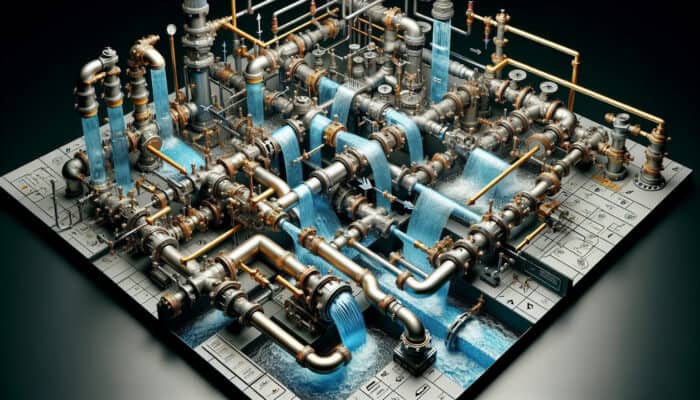Recognising the Critical Need for Backflow Testing to Safeguard Your Water Supply
Understanding Backflow: Key Concepts and Associated Risks

Backflow is the unwelcome and potentially hazardous reversal of water flow within plumbing systems, posing a significant threat to the safety of the clean water supply. This precarious situation can arise from multiple factors, including sudden fluctuations in water pressure and the existence of cross-connections within the plumbing infrastructure. Gaining insight into these critical causes of backflow is fundamental for establishing effective prevention and management strategies. Typical causes of backflow include:
- Sudden fluctuations in water pressure, frequently resulting from emergency firefighting efforts or a marked uptick in water usage.
- Back siphonage, which occurs when a water main ruptures, creating a vacuum effect.
- Backpressure caused by pumps or thermal expansion within heating systems.
- Cross-connections between potable and non-potable water systems.
By acquiring knowledge about these pivotal factors, property owners in Port Moody can make substantial contributions to the essential endeavour of protecting the local water supply, which is critical for public health and the well-being of the community.
The Essential Value of Consistent Backflow Testing for Drinking Water Safety
Implementing regular backflow testing is an indispensable precaution that ensures the safety of drinking water for every resident. By detecting potential issues at an early stage, property owners can prevent the serious ramifications associated with contaminated water supplies. Routine testing reveals weaknesses in backflow prevention systems that might otherwise go unnoticed. This proactive strategy not only reduces health risks but also avoids costly remedial measures in the future. For the residents of Port Moody, ongoing backflow testing fosters confidence in the municipal water system while adhering to vital community health standards and safety protocols.
Navigating Regulations for Backflow Prevention Compliance: Essential Knowledge
In Canada, backflow prevention is subject to stringent municipal and provincial regulations aimed at protecting public health. For both residents and business proprietors in Port Moody, compliance with these regulations is not just a legal obligation; it represents a deep ethical commitment. The local health authority stipulates that all properties deemed at risk of backflow must have operational prevention devices installed and undergo regular testing. Familiarising oneself with these regulations not only ensures that property owners remain compliant but also aids in avoiding potential fines while safeguarding public health and preserving the quality of the water supply.
Understanding the Risks of Neglecting Backflow Testing

Neglecting regular backflow testing can result in severe consequences. The health hazards linked to contaminated water are significant, potentially leading to outbreaks of waterborne diseases that could affect entire communities and endanger vulnerable populations. Moreover, failing to maintain backflow systems could necessitate extensive and costly repairs to plumbing infrastructure, imposing a substantial financial burden on property owners. Without proper testing, issues may remain hidden until they develop into more serious problems, underscoring the urgent need for vigilance in backflow prevention practices and ongoing maintenance.
Professional Perspectives on Backflow Testing Services in Port Moody
Establishing the Recommended Frequency for Backflow Testing
The frequency of backflow testing can vary depending on the type of property and local regulations. However, it is generally advisable to conduct testing annually. For example, commercial properties in Port Moody may face stricter guidelines that require more frequent testing. Residential properties, while typically on an annual schedule, might necessitate more frequent assessments if they have intricate plumbing systems or are located near potential contamination sources, such as industrial zones. These customised testing schedules ensure comprehensive oversight of backflow prevention systems, thereby safeguarding the integrity of Port Moody’s water supply and protecting public health.
What to Anticipate During a Backflow Testing Procedure

When a certified technician arrives to perform a backflow test, you can expect an exhaustive inspection of the backflow prevention device. The testing process involves scrutinising the device for any leaks, blockages, or indications of malfunction. Technicians will utilise specialised tools to measure pressure differentials, ensuring that the device operates effectively under various conditions. This thorough evaluation not only identifies immediate issues but also generates a comprehensive record of the device’s status, which is essential for regulatory compliance and ensuring the ongoing safety of the water supply.
Selecting the Most Suitable Backflow Testing Service Provider
Choosing a reputable backflow testing service is crucial for ensuring safety and compliance with regulations. Begin by researching providers in Port Moody, concentrating on those with positive customer feedback and the appropriate licensing credentials. Verify that the technicians are certified and have experience with the specific types of backflow prevention devices installed at your property. Here are some practical steps to consider:
- Examine online ratings and testimonials on platforms like Google or Yelp for insights into service quality.
- Request quotes from multiple service providers to compare pricing and services offered.
- Inquire about the company’s familiarity with local regulations and compliance standards.
- Confirm their certification and insurance status before making a hiring decision.
By adhering to these steps, property owners can identify a reliable service that prioritises safety, compliance, and professionalism, ensuring peace of mind regarding their water supply.
A Comprehensive Overview of the Backflow Testing Process
Essential Equipment Utilised in Backflow Testing Procedures
Backflow testing requires specialised equipment designed to accurately evaluate the performance of backflow prevention devices. Technicians generally use test kits, pressure gauges, and flow meters, each serving a specific function in the testing procedure. Test kits facilitate quick assessments of the device’s functionality, while pressure gauges measure the differential pressure across the device to ensure adherence to safety standards. Flow meters, conversely, provide detailed insights into water flow rates, which are critical for identifying potential issues. This advanced equipment guarantees that backflow prevention devices effectively shield the public water supply from contamination, ultimately protecting community health.
Step-by-Step Breakdown of the Backflow Testing Process
The backflow testing process is systematic and thorough, ensuring that every component of the prevention device is scrutinised for optimal performance. Initially, a technician conducts a visual inspection of the backflow device to identify any visible defects. Subsequently, the technician tests the device under a series of pressure conditions to simulate real-world operational scenarios. Detailed documentation of the results is essential for compliance with regulations and future reference. This structured approach guarantees that any deficiencies are swiftly identified and addressed, thereby ensuring the ongoing safety of the water supply in Port Moody and promoting community well-being.
Immediate Actions to Take If a Backflow Test Fails
If a backflow prevention device fails the test, it is imperative to take immediate corrective actions. The property owner bears the responsibility of arranging necessary repairs or replacements to mitigate the risk of contamination. Depending on the severity of the failure, the technician may recommend either a complete replacement or targeted repairs to restore the device to its proper operational condition. Ensuring compliance with local regulations following repairs is equally vital, as unresolved failures can have significant public health implications, jeopardising the safety of the water supply.
The Significance of Regular Backflow Testing for Public Health and Safety
Maintaining High Standards of Water Quality Through Routine Testing
Regular backflow testing is instrumental in maintaining high standards of water quality within the community. By actively preventing contamination, testing guarantees that the water remains safe for consumption, which is particularly crucial in densely populated areas like Port Moody. Property owners play a significant role in safeguarding public health by upholding their backflow devices and adhering to established testing schedules. This proactive strategy not only protects individual health but also supports broader community health initiatives, fostering trust in the municipal water supply and emphasising the importance of effective water management practices in promoting sustainability.
Increasing Property Value Through Effective Backflow Prevention Systems
A well-maintained backflow prevention system enhances property value. Properties that comply with backflow prevention regulations demonstrate responsible ownership and a commitment to essential maintenance. This compliance not only diminishes the risk of incurring costly fines but also reassures potential buyers about the safety of the water supply. In Port Moody’s competitive real estate market, showcasing a dedication to water safety can act as a distinguishing factor that elevates property appeal, ultimately benefiting owners in their investment pursuits and encouraging long-term sustainability.
Financial Gains from Investing in Consistent Backflow Testing
Investing in regular backflow testing can lead to considerable long-term savings for property owners. By identifying potential issues before they escalate into serious problems, property owners can avoid substantial repair bills and fines associated with non-compliance. Furthermore, maintaining an effective backflow prevention system minimises the risk of contamination-related health crises, which can be financially devastating. Consequently, regular testing serves not only as a crucial health precaution but also as a financial safeguard, reinforcing the necessity for consistent maintenance and vigilance to protect community resources.
The Proven Advantages of Backflow Testing Services in Port Moody
Research Supporting the Necessity of Backflow Testing
Studies indicate that regular backflow testing significantly decreases the incidence of waterborne diseases. By ensuring the integrity of water systems, municipalities can diminish public health risks associated with contaminated water supplies. Expert analyses reveal that proactive testing measures not only safeguard individual health but also yield positive community health outcomes. For residents of Port Moody, where community well-being is a shared priority, the implications of such findings highlight the critical importance of adhering to backflow testing regulations to promote public health and safety.
Case Studies Illustrating the Impact of Backflow Testing
Numerous case studies from Port Moody showcase the effectiveness of backflow testing in preventing contamination. For instance, a local restaurant successfully avoided a significant contamination incident by adhering to a rigorous testing schedule. Following a routine test, technicians identified a leaking valve that could have resulted in severe contamination. Addressing the issue promptly not only protected their customers but also reinforced community trust in local businesses. These real-world examples emphasise the essential role of backflow testing in safeguarding public health and maintaining community confidence in local water systems.
Long-lasting Health Benefits Linked to Consistent Backflow Testing
Consistent backflow testing offers long-term health benefits that extend beyond immediate safety concerns. By ensuring a dependable water supply, communities can mitigate risks associated with potential contamination events. This is particularly vital in densely populated areas of Port Moody, where the implications of water quality directly affect public health. A commitment to regular testing fosters a culture of safety and responsibility, reinforcing the importance of proactive measures in maintaining community well-being and trust in local water systems, while also supporting sustainable practices.
Best Practices for Efficient Backflow Prevention
Key Recommendations for Installing Backflow Prevention Devices
Proper installation of backflow prevention devices is crucial to their effectiveness. Adhering to manufacturer guidelines and local regulations guarantees that these devices function as intended. When installing backflow devices, consider the following essential recommendations:
- Select the appropriate type of backflow prevention device based on the specific plumbing system requirements.
- Follow local plumbing codes and regulations throughout the installation process to ensure compliance.
- Ensure that the installation location is easily accessible for future testing and maintenance.
- Conduct a thorough post-installation inspection to verify that the device is functioning correctly and efficiently.
By adhering to these recommendations, property owners help prevent future complications and uphold essential water safety standards, ensuring the protection of the community’s water supply and promoting public health initiatives.
Establishing Effective Maintenance Schedules for Backflow Devices
Creating a regular maintenance schedule is vital for keeping backflow prevention devices in optimal condition. This includes not only annual testing but also periodic inspections to identify potential issues before they arise. Property owners should consider incorporating maintenance into their routine property management practices, ensuring that devices receive the necessary care over time. This proactive approach not only enhances the longevity of the devices but also secures compliance with local regulations, ultimately benefiting both property owners and the community at large by promoting safety and health.
Avoiding Common Mistakes in Backflow Prevention Practices
Being aware of common mistakes can help prevent significant issues in backflow prevention practices. Failing to conduct regular testing is the most critical error, as it may lead to undetected failures and potential contamination. Other prevalent pitfalls include improper installation, which can compromise the effectiveness of the devices, and neglecting to promptly address identified issues. Recognising these mistakes empowers property owners to take proactive measures in safeguarding their water supply, fostering a culture of responsibility and care that benefits the entire community.
The Significance of Training and Certification for Backflow Prevention Specialists
Proper training and certification for installers and maintenance personnel are paramount to effective backflow prevention implementation. Skilled technicians possess the necessary expertise in handling equipment and adhering to safety standards, significantly enhancing the reliability of backflow prevention systems. For property owners in Port Moody, ensuring that the service providers they engage are adequately trained and certified is crucial for compliance and safety, reinforcing the importance of selecting reputable and qualified service providers to protect public health.
Preparing Effectively for a Backflow Test
Streamlining the Testing Process: Essential Steps for Property Owners
To facilitate a seamless backflow testing process, property owners should ensure that technicians have unobstructed access to the backflow prevention device. This may involve clearing away any obstacles and confirming that the area is well-lit and safe for testing. Additionally, having any necessary documentation readily available aids in providing a comprehensive assessment of the device’s history and condition. Proactive preparation not only helps the technician perform their job more efficiently but also enhances the overall effectiveness and efficiency of the testing process, ultimately securing the community’s water supply.
Necessary Documentation for Backflow Testing
Having the appropriate documents readily available can significantly expedite the backflow testing process. Property owners should prepare records of previous tests, installation documents, and maintenance logs. These documents provide crucial context for technicians, enabling them to make informed assessments about the backflow prevention device’s history and current condition. Keeping organised documentation also ensures compliance with local regulations, offering peace of mind for property owners who wish to uphold safety standards and protect the integrity of their water supply.
Post-Test Protocol: Essential Actions for Property Owners Following the Backflow Test
Once the backflow test is complete, property owners should engage with the technician to review the results. Understanding the findings enables property owners to identify necessary repairs or follow-up tests. Promptly implementing any recommended changes is essential for maintaining compliance and ensuring ongoing safety. Additionally, keeping detailed records of the test results and any subsequent actions taken supports regulatory compliance and aids in future maintenance planning, contributing to the overall effectiveness of backflow prevention efforts and safeguarding the health of the community.
Common Questions Regarding Backflow Testing Answered
What Is the Purpose of Conducting Backflow Testing?
Backflow testing is a vital procedure designed to assess the functionality of backflow prevention devices, ensuring the avoidance of contamination in the clean water supply and safeguarding public health.
How Frequently Should Backflow Testing Be Conducted?
Typically, backflow testing is recommended to be performed annually, although local regulations or specific property types may necessitate more frequent testing to ensure ongoing safety and compliance.
What Signs Indicate That a Backflow Device May Be Failing?
Indicators of a failing backflow device include visible leaks, unexpected changes in water pressure, or signs of contamination in the water supply, all of which require immediate attention to avert potential health hazards.
Who Is Responsible for Conducting Backflow Testing?
Property owners are responsible for ensuring that their backflow prevention devices are tested regularly and maintained according to local regulations and guidelines, actively promoting community health and safety.
Which Types of Properties Are Required to Undergo Backflow Testing?
Commercial properties, multi-family residences, and any property with potential cross-connections or contamination risks are mandated to undergo backflow testing to protect public health and ensure a secure water supply.
What Is Involved in Performing a Backflow Test?
During a backflow test, a certified technician meticulously inspects the device, measures pressure differentials, and documents the results to guarantee compliance with safety standards and ensure the integrity of the water supply.
Can Property Owners Perform Backflow Testing Themselves?
No, backflow testing must be conducted by certified professionals who are trained to ensure accurate results and compliance with safety regulations, effectively protecting public health and water quality.
What Should Be Done If a Backflow Device Fails the Test?
If a backflow device fails, immediate repairs or replacements must be arranged to prevent contamination. The property owner should ensure compliance with local regulations following the repairs to safeguard the community's water supply and public health.
Are There Any Penalties for Non-Compliance with Backflow Testing Regulations?
Yes, property owners may face fines and penalties for failing to comply with backflow testing regulations set forth by local authorities, emphasising the importance of adherence to safety standards and community health protection.
How Can I Find a Certified Backflow Testing Service in Port Moody?
To locate a certified backflow testing service in Port Moody, research local providers online, read reviews, and verify their certifications to select a reputable service that prioritises safety and compliance.
Connect with us on Facebook to stay updated on essential water safety tips!
The Article: Backflow Testing Services in Port Moody: Ensuring Water Safety First Published On: https://pacificbluemechanical.ca/
The Article: Backflow Testing Services: Safeguarding Water in Port Moody first appeared on https://writebuff.com
The Article Backflow Testing Services to Protect Water in Port Moody Was Found On https://limitsofstrategy.com
The Article Backflow Testing Services in Port Moody for Water Safety found first on https://electroquench.com

